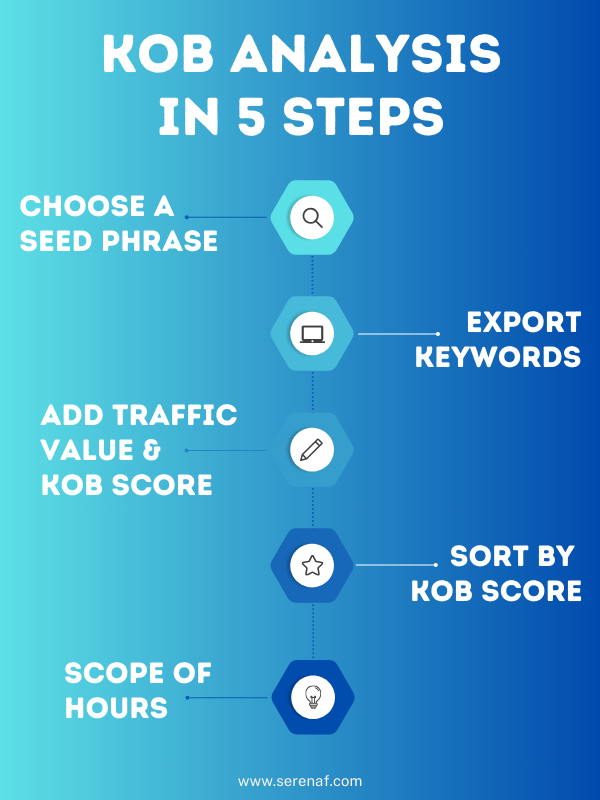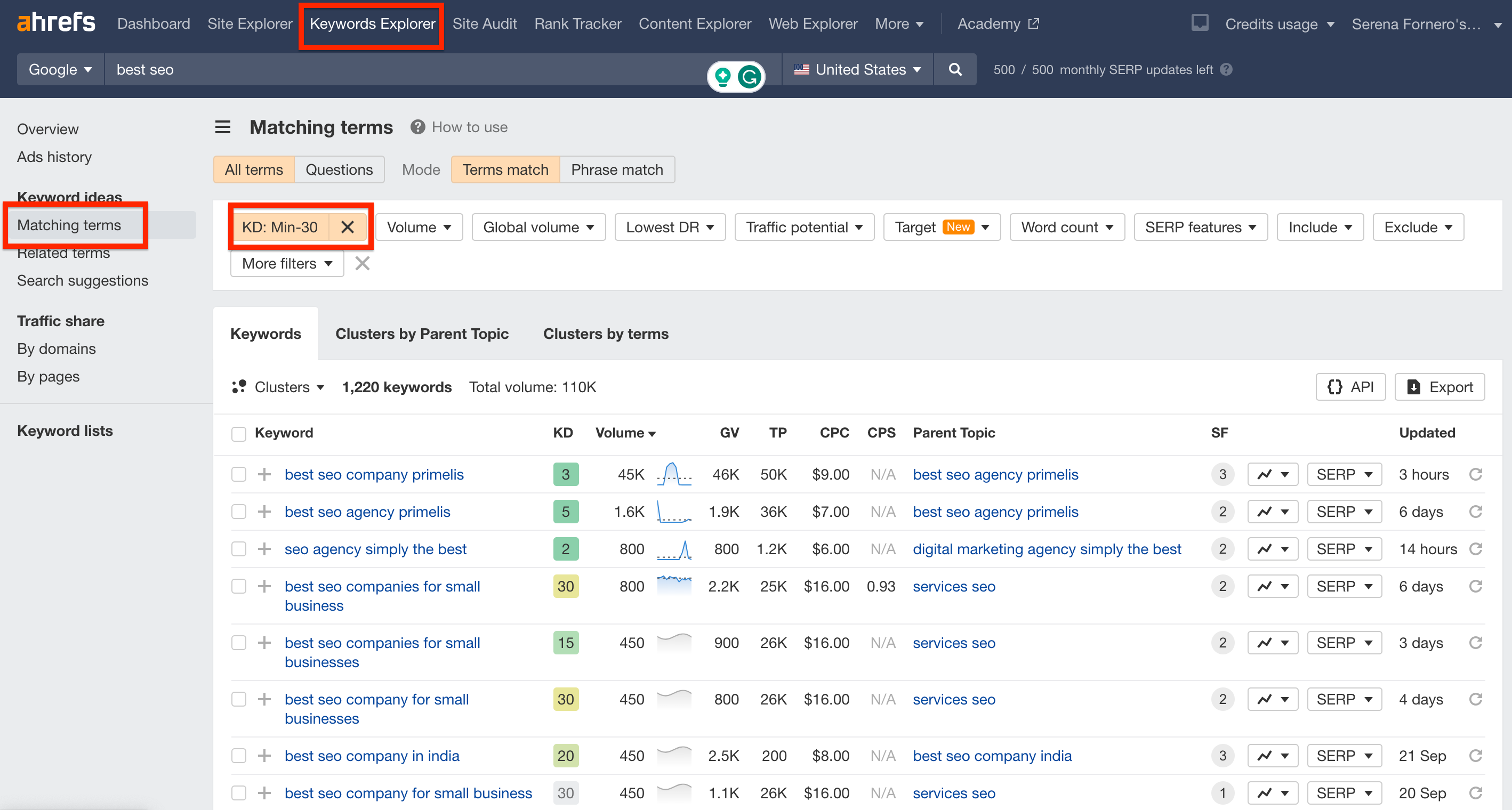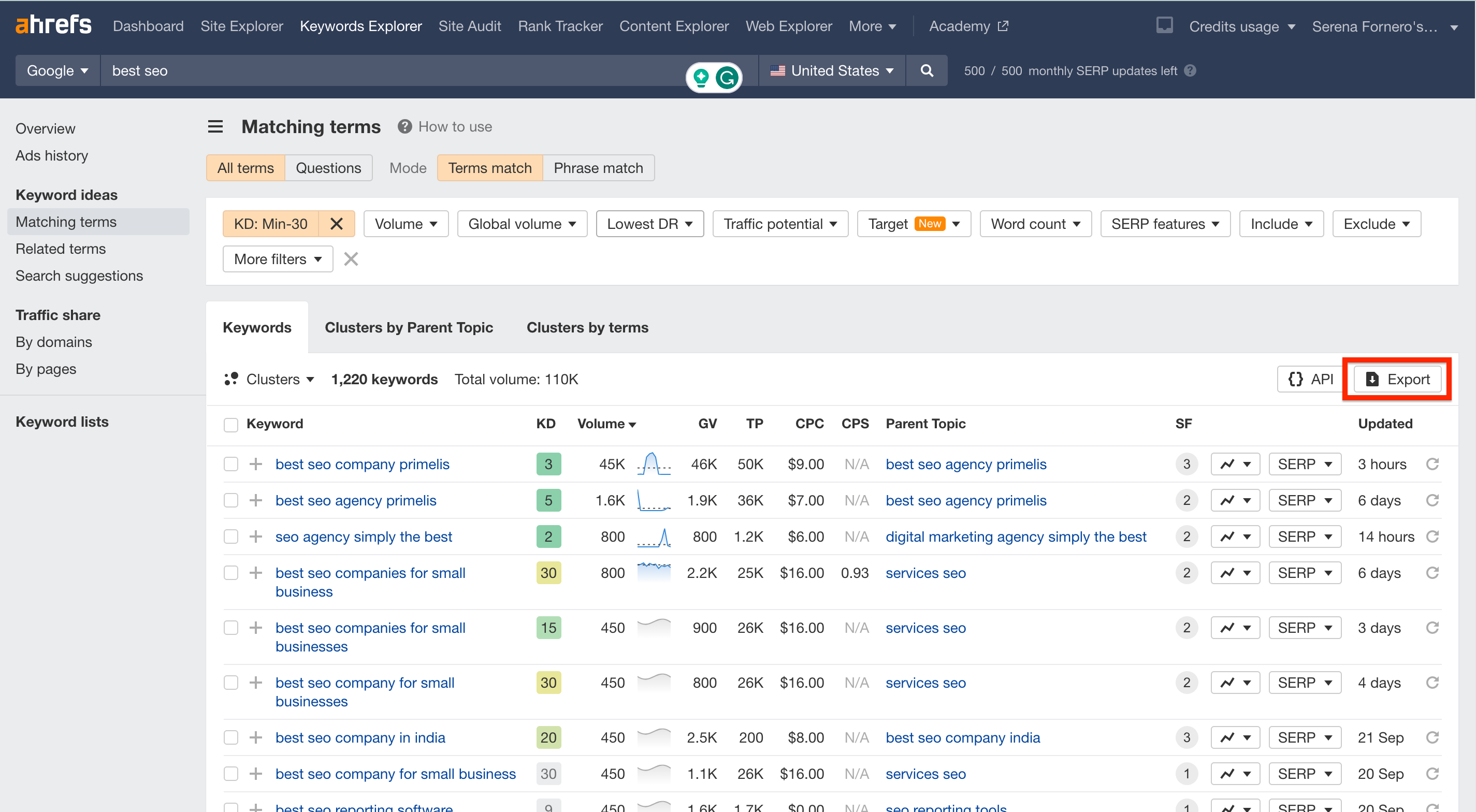Are you looking for ways to drive more traffic and engagement to your website?
Do you want to identify exactly which keywords to prioritize and build an ad hoc content strategy for your own blog or for a client?
KOB Analysis is a powerful method to research keywords with high returns in a short period of time.
Keyword opposition to benefit can save you time and effort during the content prioritization process.
Plus, even beginners can easily learn how to perform KOB Analysis on their own by following these 5 simple steps:
- Choose a seed phrase
- Export keywords list
- Add Traffic Value and KOB Score columns
- Sort and organize your list
- Scope of Hours
Let’s deep dive into these 5 easy steps to perform a full KOB Analysis.
What is a KOB Analysis?
KOB Analysis, short for Keyword Opposite to Benefit Analysis, is an advanced form of keyword research.
It is used to understand the value of keywords and prioritize them while building a content strategy for your blog or a client.
This easy process can be done using a keyword tool, a spreadsheet, and a math formula to find out each keyword’s exact traffic value and KOB score.
By performing KOB analysis, businesses can optimize their usage of keywords to achieve the highest return with the least amount of time and expense.
Why is KOB Analysis important?
Understanding Your Customers
KOB Analysis is an important tool for understanding your customers and their needs.
It helps you identify who your target audience is, what their interests are, and how they make decisions.
Whether you have your own business, or working with a client, with KOB Analysis you gain insights into your customers’ buying habits and preferences.
This means that you can create more effective marketing campaigns and products that meet the needs of your target market.
Easier Content Planning
Keyword opposition to benefit analysis provides you with a comprehensive list of keywords that can be used for long and short-term content planning.
This way you can stop wasting time trying to find the perfect keyword each time before creating new content. You’ll always know what to publish and the actual value related to a specific keyword.
Based on the KOB Score and traffic value you’ll always know what to prioritize in order to rank faster and what can be postponed and inserted in a longer-term content plan.
Identifying New Opportunities
KOB Analysis can also be used to identify new opportunities for growth and expansion.
By understanding your customers’ needs and interests, you may be able to spot trends or niches in the market that could be ripe for exploitation by your business.
How to perform a KOB Analysis in 5 easy steps
Doing a KOB Analysis is not as difficult as it may sound if you follow these 5 easy steps:

Choose a seed phrase
Start with keyword research.
You can use keyword tools like Ahrefs or Semrush to find one or more keyword opportunities in your niche.
Avoid choosing keywords that are too broad, for example in the niche of SEO the keyword “SEO” is too broad, and the search might not give you usable results. Whereas, “Best SEO” might work better.
There are two types of KOB Analysis:
One for Informational Keywords: “HOW + KEYWORD”
One for Transactional Keywords: “BEST + KEYWORD”

Insert the seed phrase in the keyword tool, then click on “matching terms” and the tool will propose a list of keywords.
Sort this list based on KD (keyword difficulty), to avoid having keywords with high ranking difficulty.
My suggestion is to set it to a maximum KD based on your domain rate.
For example, if your domain rate is 20, put a maximum keyword difficulty of 20.
Export Keywords List
Once the keyword research process is completed, export the keywords of your choice into a Google Spreadsheet.

Once exported, clean up unnecessary data and columns that you don’t need to perform the KOB Analysis, in order to have a cleaner space to work on.
For example, SERP Features, Last update, CPS, and Country can be deleted.
Add Traffic Value and KOB Score columns
Add to your spreadsheet the traffic value column and the kob score column.

Both these values will be extremely helpful when it comes to deciding which keyword to prioritize over a similar one.
What is Traffic Value and how to calculate it?
Keyword value traffic refers to the potential earnings a website can generate from organic traffic results when it ranks for a specific keyword.
A higher value means a bigger potential benefit for your website.
The traffic value can be calculated by multiplying CPC by Traffic potential.
Traffic Value Formula: CPC * Traffic Potential
What is KOB Score and how to calculate it?
Once defined the traffic value it’s time to calculate the KOB Score.
The KOB Score is the value defined by dividing the traffic value number by the keyword difficulty.
Basically, The higher the KOB score, the better the keyword return.
KOB Formula: Traffic Value/Keyword Difficulty
Sort and organize your list
In this last step, sort your keywords by KOB Score.
As we previously said, make sure to prioritize keywords with higher KOB Score, Traffic Value, and search Volume.
Scope of hours
To better manage your remaining topics, assign a specific number of hours for keywords.
This will give you a more accurate estimate of the time needed to cover each topic thoroughly.
Establishing time allocation for each keyword can significantly impact your prioritization strategy.
Frequently Asked Questions
What tools do I need to perform keyword opposition to benefit analysis?
To perform KOB Analysis you need:
- SEO tool to research target keywords
- Google Spreadsheet
What is keyword difficulty?
Keyword difficulty is a measure by which a search engine can evaluate whether a search query ranks for a keyword in a search engine.
Its difficulty can vary largely depending largely on the domain authority and quality of the pages.






[…] a KOB Analysis (Keyword Opposition to Benefit analysis) can be a great way to discover new topics and prioritize […]
[…] An advanced method involves using advanced techniques like Keyword Opposition to Benefit (KOB) Analysis. […]